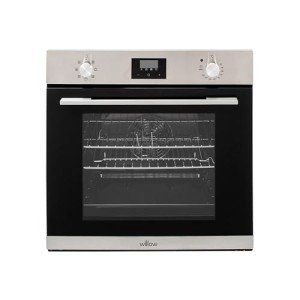Understanding Electric Integrated Ovens: A Comprehensive Guide
As technology continues to advance, the kitchen device market has actually seen an amazing transformation, particularly with the introduction of electric integrated ovens. These appliances provide a seamless blend of modern style and performance, emerging as vital tools for both amateur and professional chefs alike. This article will look into the different elements of electric integrated ovens, highlighting their functions, benefits, and considerations when purchasing.
What is an Electric Integrated Oven?
An electric integrated oven is a built-in cooking home appliance that is created to fit effortlessly into kitchen cabinets. Unlike freestanding ovens, integrated ovens are typically flush with the surrounding cabinets, providing a streamlined aesthetic. Full Document are usually powered by electrical energy, which offers consistent cooking temperature levels and precise control.
Key Features of Electric Integrated Ovens
Electric integrated ovens include a wide range of features that cater to differing cooking requirements. Here are some of the crucial features:
- Design Flexibility: The built-in style enables customized configurations according to kitchen designs.
- Numerous Cooking Modes: Most electric integrated ovens offer diverse cooking modes, including baking, broiling, roasting, and convection.
- Self-Cleaning Options: Many models consist of self-cleaning features that utilize high temperatures to burn off food residues.
- Smart Technology: Advanced models come with clever functions allowing users to manage the oven from another location through smartphone apps.
- Energy Efficiency: Electric ovens are typically created to consume less energy compared to their gas counterparts.
Benefits of Electric Integrated Ovens
Electric integrated ovens provide various benefits for home cooks. Below are a few of the most substantial benefits:
- Space-Saving Design: The combination into kitchen cabinetry maximizes kitchen space, making it ideal for smaller sized kitchen areas.
- Visual Appeal: The smooth appearance boosts the total look of a kitchen, providing it a modern-day and polished finish.
- Constant Cooking Performance: Electric ovens disperse heat uniformly, leading to much better cooking outcomes.
- Safety Features: Many integrated models feature safety functions such as vehicle shut-off and cool-touch doors, lowering the threat of mishaps.
- Versatile Cooking Options: The ability to change between different cooking modes supplies versatility for numerous cooking designs.
| Feature | Description |
|---|---|
| Style Flexibility | Built to suit existing kitchen cabinetry |
| Several Cooking Modes | Bake, broil, roast, and convection choices |
| Self-Cleaning Options | High-temperature cleaning for upkeep |
| Smart Technology | Remote control for enhanced ease of usage |
| Energy Efficiency | Lower energy intake compared to gas ovens |
Considerations When Purchasing an Electric Integrated Oven
Selecting the best electric integrated oven requires careful factor to consider of various aspects. Here's a list of points to bear in mind:
- Size and Capacity: Assess the space readily available in your kitchen and the size of the oven that fits easily while still providing appropriate cooking capacity.
- Cooking Features: Identify the cooking includes that are necessary for your requirements, such as convection cooking or steam cooking.
- Cost Range: Determine your budget and assess the alternatives readily available within that range, keeping in mind that higher-end models often feature sophisticated features.
- Setup: Consider the setup procedure and whether expert aid is required to ensure a smooth fit.
- Energy Rating: Look for ovens with good energy rankings to minimize long-lasting electricity expenses.
Typical Types of Electric Integrated Ovens
Several kinds of electric integrated ovens deal with diverse cooking environments and user preferences. Here are some typical choices:
- Single Ovens: This is the most typical type, suitable for typical home cooking needs.
- Double Ovens: These ovens offer two different compartments, allowing for multitasking.
- Compact Ovens: Smaller in size, these designs are perfect for kitchens with limited space.
- Steam Ovens: Incorporating steam cooking, these ovens are outstanding for much healthier meal preparation.
- Wall Ovens: Installed within the wall, these ovens conserve space and provide a higher cooking range.
Often Asked Questions (FAQs)
Q1: How do I tidy my electric integrated oven?
A: Most contemporary electric integrated ovens come with self-cleaning functions. However, for manual cleaning, it's recommended to use non-abrasive cleaners and a soft fabric. Always refer to the manufacturer's standards for specific cleaning directions.
Q2: Can I install an electric integrated oven myself?
A: While some property owners may try a DIY installation, it is recommended to hire a professional for a smooth fit, guaranteeing that the electrical connections are safe and certified with local codes.
Q3: Are electric integrated ovens energy-efficient?
A: Yes, electric integrated ovens are typically more energy-efficient than gas ovens. Look for models with high energy scores for ideal efficiency.
Q4: What cooking modes should I try to find?
A: Look for ovens offering versatile cooking modes like convection baking, broiling, and steam cooking, which can boost your cooking experience.
Q5: Do electric integrated ovens require routine maintenance?
A: Yes, routine upkeep, consisting of cleaning and ensuring that seals are undamaged, will extend the oven's life-span and improve cooking efficiency.
Electric integrated ovens are an exceptional addition to any modern-day kitchen, combining aesthetic appeal with versatile cooking functionalities. They not just conserve space but also offer innovative functions that can elevate cooking experiences. By comprehending their characteristics and advantages, consumers can make educated choices when selecting an electric integrated oven that best satisfies their cooking needs. Ultimately, these ovens stand as a testament to the development of kitchen technology, catering to the needs of today's striving chefs.

